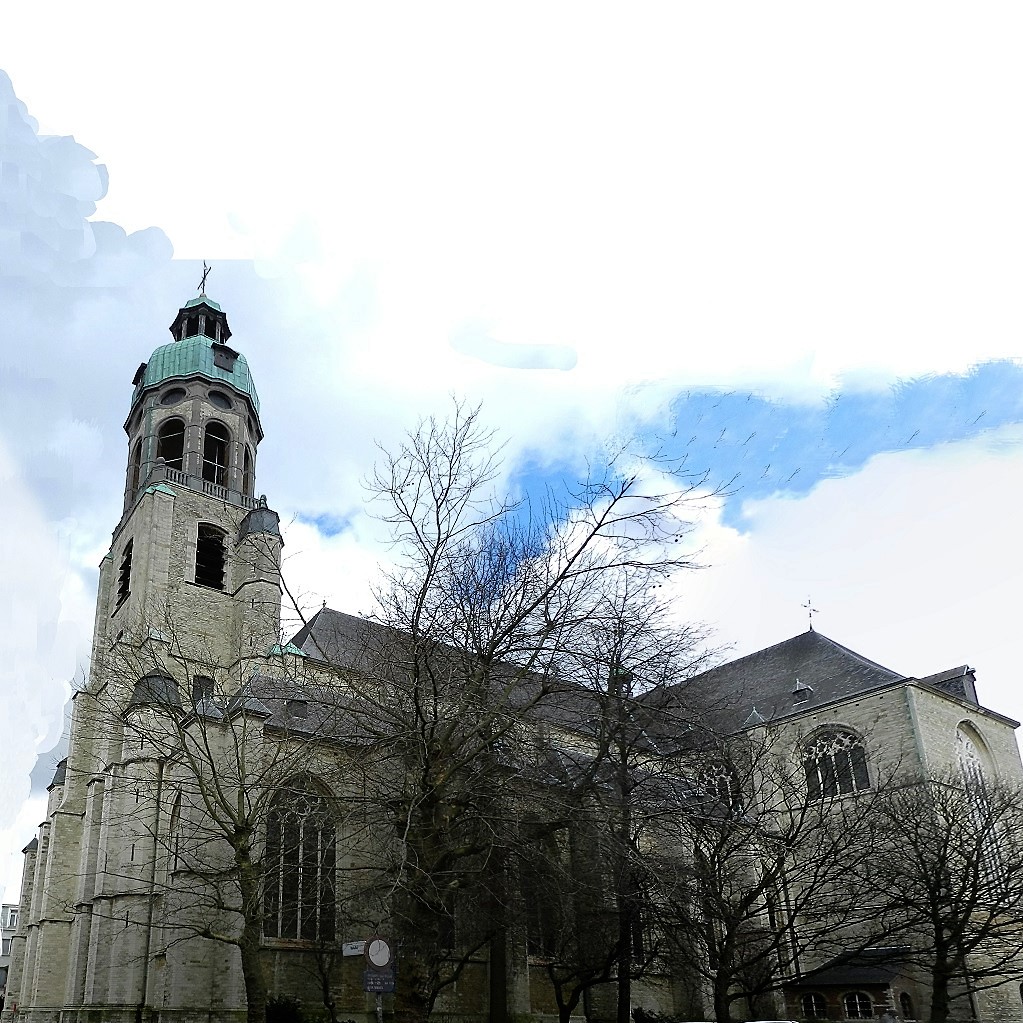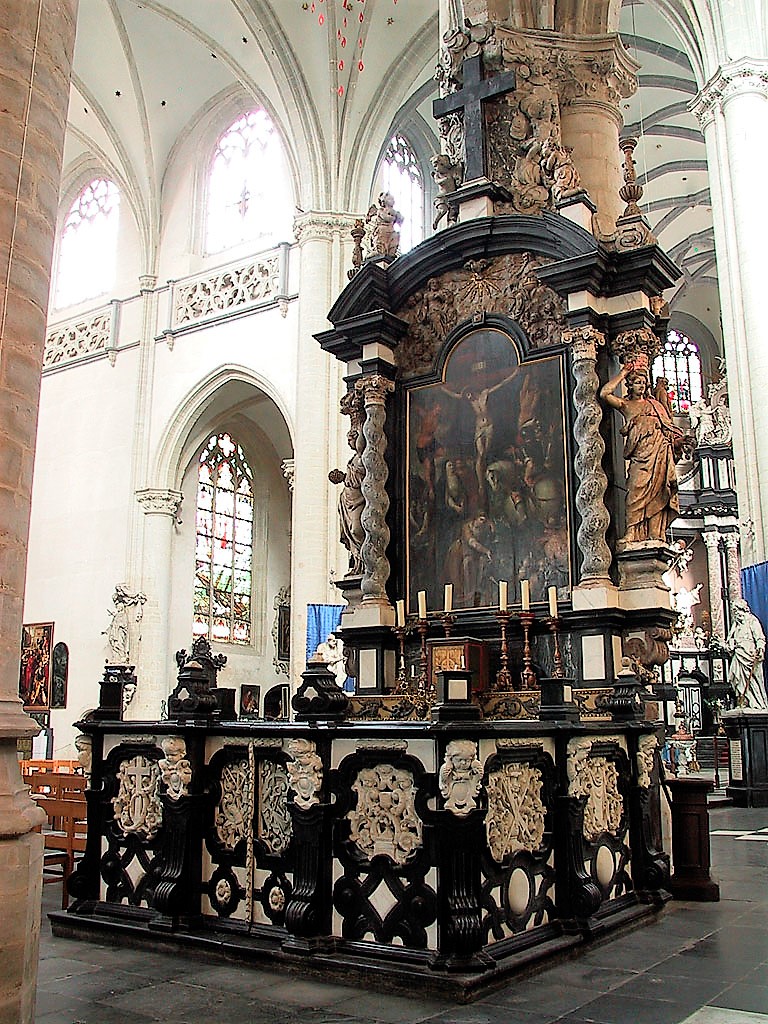Antwerp's St Andrew's Church, a revelation.
The Holy Cross Altar and the Holy Cross Monument
The Holy Cross Altar
‘Holy Cross’ refers to the cross on which Jesus died. True to medieval symbolism this devotion to Jesus’s sacrifice of love is situated at the sunny southern side of the church. Since Catholic worship was restored in 1585 the wooden Holy Cross altarThe altar is the central piece of furniture used in the Eucharist. Originally, an altar used to be a sacrificial table. This fits in with the theological view that Jesus sacrificed himself, through his death on the cross, to redeem mankind, as symbolically depicted in the painting “The Adoration of the Lamb” by the Van Eyck brothers. In modern times the altar is often described as “the table of the Lord”. Here the altar refers to the table at which Jesus and his disciples were seated at the institution of the Eucharist during the Last Supper. Just as Jesus and his disciples did then, the priest and the faithful gather around this table with bread and wine. has been in the southern aisleLengthwise the nave [in exceptional cases also the transept] of the church is divided into aisles. An aisle is the space between two series of pillars or between a series of pillars and the outer wall. Each aisle is divided into bays., but not always against the same pillar. In 1603 it was given the representation of Calvary by Frans I Francken.
In 1663, immediately after the transepts had been accomplished, the altar received a new position against the south-western crossingThe central point of a church with a cruciform floor plan. The crossing is the intersection between the longitudinal axis [the choir and the nave] and the transverse axis [the transept]. pillar. For the brotherhood this was the occasion to replace it by the Baroque portico altar by Cornelis van Mildert (1664-1665). Of the altarpiecePainted and/or carved back wall of an altar placed against a wall or pillar. Below the retable there is sometimes a predella. only the central panel was preserved, with some smaller adaptations.
In the centre of the painting Jesus is hanging, nailed to the cross. His head is bent to the right: for He is already dead. His ashen body contrasts with the dark red sky, illustrating Biblical “darkness”. Above Him is the trilingual explanatory caption, each version being limited to four initials. His mother Mary and John the apostleThis is the name given to the principal twelve disciples of Jesus, who were sent by Him to preach the gospel. By extension, the term is also used for other preachers, such as the Apostle Paul and Father Damien (“The Apostle of the Lepers”). are the only ones who stand by him in these last moments by standing by Him (iconographically on the right). In the foreground Mary Magdalen embraces the cross. On Jesus’s left and right are the crucified murderers. Their hands are tied with ropes, only their feet have been nailed. The repentant, also called ‘good’, murderer, (iconographically) right of Jesus, looks at Him longingly. To the ‘bad murderer’, on His left and looking away, are shown the two tablets of the (Jewish) law: an allusion to the Christian custom of showing the crucifix to the condemned. The soldiers who are dicing for Jesus’s clothes have real character heads with true villain’s faces. Two bohemian types look on: a disabled one with a stick and holding a cute dog on his lap; the other one has a strikingly red nose, which might be explained by the small barrel in the bottom right corner… In the bottom left corner there is a wicker basket with tools for the crucifixion. The skull and the separate jawbone at the foot of the cross do not only refer to the name of the place of the execution: Golgotha or Place of a Skull. In the first place the so-called Adam’s skull indicates the extent of the event: by His sacrifice of love until His death on the cross Jesus has liberated all mankind from the power of evil, or the original sin.
This Calvary was spread by a print containing a devotional poem and a woodcut after the painting, by Christoffel Jegher (1637), who was also a parishioner of SaintThis is a title that the Church bestows on a deceased person who has lived a particularly righteous and faithful life. In the Roman Catholic and Orthodox Church, saints may be venerated (not worshipped). Several saints are also martyrs. Andrew’s. In January 1886 this scene, and more specifically the red colours of the sunglow, was admired by apprentice painter Vincent van Gogh.
This side altar in the form of a portico is exceptionally high Baroque, even for Antwerp, and many an interior painter has been attracted by this picturesque corner. The two inner pillars are heavy twisted specimens. Even more Baroque are the outer pillars in the form of caryatid sculptures. The hyper realistic wicker flower basket they are holding on their heads with their hands is a successful sculptural form of a functional capital. These flower girls, turning somewhat to the outside, give this altar a vivid and festive character.
Because also the brotherhood of Holy TrinityThe concept that there is one God who shows himself in threefold form: Father, Son (Jesus of Nazareth) and the Holy Spirit. used this altar, on top of the altarpiece the tympanum was added with a representation of Holy Trinity in 1707. Later the membership list of this brotherhood was hung at the back of this pillar and in 1966 the last stained glass window in the southern aisle was devoted to the Triune God.
The altar rails were made by Jan and Jan Antoon Van den Cruyce (1671-1672). White panels in which the tools of the passion have been incorporated very decoratively contrast with the black marble of the constructive frame.
- North: The cock of Peter’s denial
A bulrush, referring to the reed stem Jesus was given as a sceptre after His flogging, crossed with the hyssop stem with which a sponge with sour wine was passed to Him at the cross.
- South: A veilHeadgear worn by female religious. Until the Second Vatican Council, all nuns wore wimples, which covered the entire hair and neck. Nowadays, the veil is usually worn on the hair. of Veronica
The sword with which Peter cut off Malchus’s, the high priest’s servant’s, ear, the whip with which Jesus was flogged and the lance with which Jesus’s heart was pierced. Notice the two masks in the plant motive!
- West: Left: the cross
Right: the cup of the Last Supper. In His agony Jesus asked to take this away from Him.
The wooden door panels, painted in the colours of the marble, show the tools that were needed for the crucifixion. On the left door there are a glove and a lantern that gave light to the soldiers when they came to arrest Jesus in the Garden of Olives, the ladder for the crucifixion and a cloth. On the right door there are the cane, the hammer and the pincers for the crucifixion.
On the plinths of the set of candle holders of this altar the cross is flanked by emperor Constantine and his mother, empress Helena. In 313 Constantine the Great granted religious freedom to the Christians after his victory ‘in the sign of the cross’, so that henceforth the cross could be shown publicly as a sign of faith. According to tradition the emperor’s mother found the cross of Christ.
Monument for the Holy Cross
As if an altar was not sufficient, at the end of the 18th century also a separate monument was constructed for the relicA remnant of the body of a saint or a (part of) an object that has been in contact with a saint, Jesus, or Mary. The very first sanctuaries were built on graves of saints. Remnants of these saints were distributed to other churches and chapels. The first altars were usually the sarcophagi of the saints. Hence the custom of placing relics under the altar stone. Relics are also kept in shrines, and sometimes displayed in reliquaries. of the Holy Cross. This object of devotion found a home here after the contemplative White Sisters ConventComplex of buildings in which members of a religious order live together. They follow the rule of their founder. The oldest monastic orders are the Carthusians, Dominicans, Franciscans, and Augustinians [and their female counterparts]. Note: Benedictines, Premonstratensians, and Cistercians [and their female counterparts] live in abbeys; Jesuits in houses. was considered ‘useless’ and abolished in 1784. The Baroque group of statues has been built up around Jesus on the cross, with at His feet the pair of brothers Peter and Andrew with their respective crosses. After all everybody has ‘his cross to bear’. This variety of different shapes of crosses is the most beautiful illustration imaginable of Jesus’s appeal:
“Whoever wishes to come after me must deny himself, take up his cross, and follow me.” (Mth. 16:24)
“Whoever does not take up his cross and follow after me is not worthy of me.” (Mth. 10:38)
“No disciple is above his teacher” (Mth. 10:24), “but when fully trained, every disciple will be like his teacher.” (Lk. 6:40)

- Saint Andrew’s Church
- History and description
- Introduction
- The historical context
- Building history
- The patron saint
- The outbuildings
- The tower
- Spatial effect
- Saint Andrew’s identity card
- Saint Andrew in Art
- Saint Andrew in ‘his’ church
- The ancient high altar
- The current high altar
- Choir and chancel
- The choir stalls
- The celebration altar
- The Venerable Chapel
- The Mary Chapel
- The Minters’ Altar
- What is Truth?
- Holy Cross Altar
- Saint Anne’s Altar
- The pulpit
- The confessionals
- The organ
- Stained glass – southern aisle
- Stained glass – northern aisle
- The Way of the Cross
- Funeraria
- The treasury
- Bibliography


